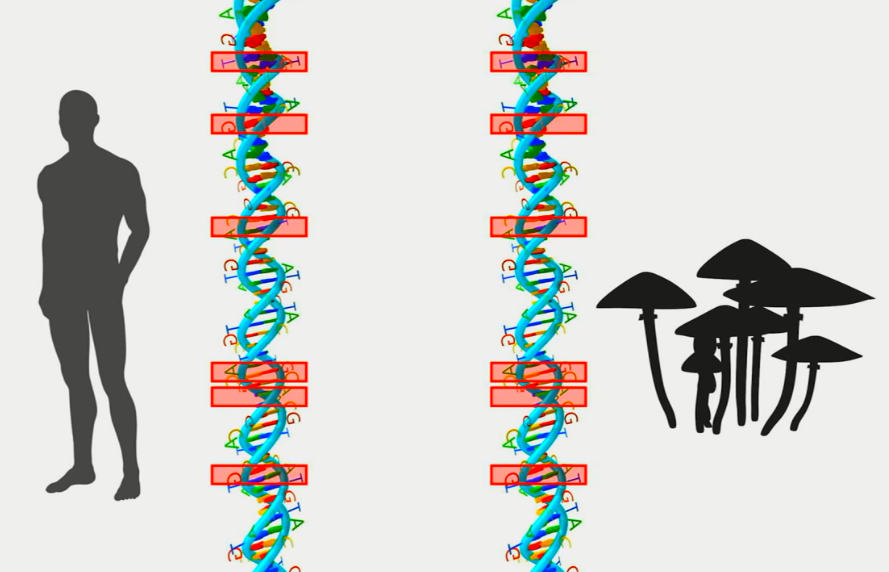(单词翻译:单击)
Geckos and grasshoppers, worms and watermelons, elephants and Escherichia Coli, man and mushroom.
壁虎和草蜢,蠕虫和西瓜,大象和大肠杆菌,人和蘑菇,
All so different in form and function,
在形式和功能上完全不同
but amazingly the same in how their form and function are determined.
但是令人惊讶的是决定他们的组成和功能的因素却是相同的!
First, all these organisms are made of one or more cells, and every cell of every living thing on earth
首先,所有的这些有机体都是由单个或多个细胞组成的!而且地球上任何生物的任何细胞
contains all the information it takes to create and duplicate and make variations of itself.
都包含它所携带的所有信息,使其能制造并复制组成其身体的各个组成部分!
That information is stored in a very long but quite simple double molecule called DNA, or Deoxyribonucleic Acid.
这些信息都储存在一条非常长但很简单,被称为DNA的双分子链上,或称为脱氧核糖核酸
And the DNA of every living organism is made of chains of four smaller molecules called nucleotides.
每个生命体的DNA都是由四个被称为核苷酸的小分子组成的链
What dictates the difference between a man and a mushroom is the sequence of these nucleotides in the long DNA chain.
人和蘑菇之间的差异是由长长的DNA链条中核苷酸的序列所决定的
The four differing nucleotide parts, called bases,
四种不同的核苷酸片段被称为碱基
are made of a few carbon, oxygen, hydrogen, nitrogen and phosphorus atoms, and the molecules look like this.
它们由少量的碳、氧、氢、氮和磷原子构成,它的分子结构看上去是这样的
And each of these four bases is attached to an identical backbone molecule,
这四种碱基中的每一个都被连接到同一个糖类分子上
a sugar called deoxyribose - the 'D' in DNA - and a phosphate group.
这种分子被称为脱氧核糖-这就是DNA里的D-还有一个磷酸基团
Let's simplify these nucleotides and show them like this.
我们来简化一下这些核苷酸 这样来表示
So, a single sequence of nucleotides joined by their common sugars would look like this.
于是,由共同的五碳糖分子所串连起来的核苷酸单链看起来就像这样
And the DNA molecule where such sequences are stored looks like this.
两条这样的单链互相结合,就形成了DNA分子,就像这样
But how does a simple molecule dictate the form and function of millions of different living things?
但是,这样一个简单的分子是如何来决定成千上万种不同生物的性状的呢

You can think of DNA as a great library of information,
你可以把DNA想象成一个储存着庞大信息的图书馆
information that is used to do one thing and one thing only: direct the building of different protein molecules.
这个图书馆里储存的信息只有一个用途,那就是控制不同蛋白质分子的合成
And it's the proteins that build the cells and keep them functioning and changing and reproducing.
正是这些蛋白质构成了细胞,并且维持了它们的正常运作、变化和增殖
Here's where the familiar word 'gene' comes in.
这时大家喜闻乐见的词“基因”就闪亮登场了
If your DNA is a library of information, a gene is a book in that library.
如果你的DNA是一座储存着信息的图书馆,那么基因就是其中的一本本书
A gene is a segment of the DNA molecule. Let's say your body needs a particular protein, like insulin.
基因是DNA分子中的一个个小片段。打个比方,假如你的身体需要一种蛋白质,比如胰岛素。
To get it, some of your cells send a protein signal through the bloodstream to the cells in your pancreas, where insulin is made.
为了得到它,你身体里的某一些细胞会发出信号蛋白质分子,它们在血液里穿梭,直到抵达分泌胰岛素的胰腺
That signal protein tells other proteins in the cell's nuclei
信号蛋白指示胰腺细胞核里的其他蛋白质
to open up a part of the DNA double helix, the insulin gene, and start making insulin proteins.
去打开DNA中控制胰岛素合成的那一部分双链,也就是控制胰岛素合成的基因,然后开始合成胰岛素。
As soon as enough insulin has been produced,
一旦合成了足够多的胰岛素
another signal protein comes to the pancreas' cells that tells them to stop making insulin.
另外一个信号蛋白分子就会指示胰腺细胞停止合成
It's like looking up a book in the DNA library about insulin, and then putting it back when you're done.
就像去DNA图书馆查阅关于胰岛素的书,看完了就把它合上放回去
There are genes in DNA for visible and invisible things that make up your body,
你身体的那些性状,无论是看得见的还是看不见的,在DNA中都有其对应的基因
like genes for eye color, protein pigments, for skin color, for hair color, for stopping and starting bone growth,
有控制眼睛颜色的、色素蛋白、还有控制肤色的、控制发色的、控制骨骼发育的
for your blood type, for how many fingers or arms and legs you have, for proteins that influence how long you live.
控制血型的、控制你长多少根手指、多少只胳膊和腿的,还有控制合成那些决定你寿命的蛋白质的
Your DNA probably contains between 25 thousand and 40 thousand genes,
通常你的DNA中大概有25000到40000个基因
while the DNA of a worm or a plant or a fruit fly contains about 12 thousand to 20 thousand genes.
而在一条蠕虫或是一株植物、甚至是一只果蝇的DNA中,通常只有12000到20000个基因。
Some of those genes have quite different sequences of nucleotides than yours, and some are similar to yours.
这些基因中有一些和你的核苷酸序列大相径庭,而有一些又和你的大同小异。
Though it happens infrequently, our own nucleotide sequences can change
尽管这样的情况不常见,我们自身的核苷酸序列可能会在环境遭到破坏时
as the result of spontaneous or environmental damage which might remove or shift a nucleotide position.
或者是自发地发生改变,这些改变会导致核苷酸的缺失和移位
This changes the gene involved, and can then change the protein.
从而会改变它们关联的基因以及这些基因所控制合成的蛋白质
Most of these changes, called mutations, have very little effect on the organism or its descendants.
这些改变被称为突变,大部分的突变实际上对生物的机体或后代没有多大的影响
Some are mildly damaging, and a few can make the organism better-suited to its environment.
有一些会造成轻微的损伤,有一些甚至会使机体更加适应环境。
It is these tiny changes in DNA gene sequences, happening over millions of years, that create the differences among living organisms,
千百年来,正是这些发生在DNA中的微小变化才创造了纷繁多姿的生命世界
from geckos to grasshoppers, worms to watermelons, elephants to Escherichia Coli, and man to mushroom.
从壁虎到草蜢,从蠕虫到西瓜,从大象到大肠杆菌,从人类到蘑菇。


